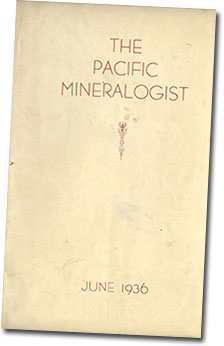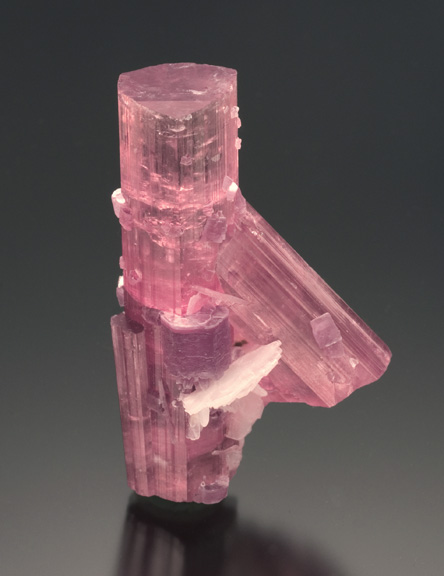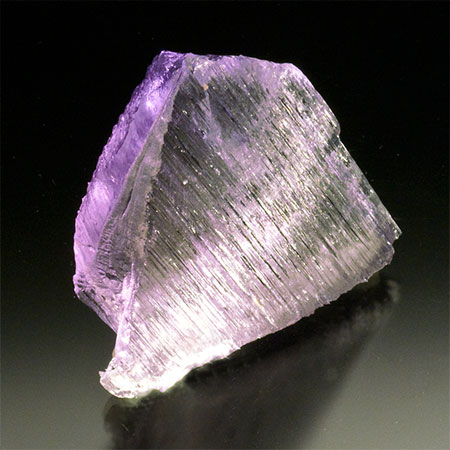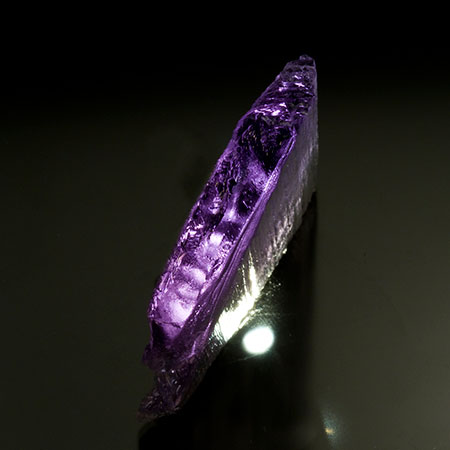![]()
With Pala Presents, we offer selections from the library of Pala International’s Bill Larson, who shares with us some of the wealth of information in the realm of minerals and mineralogy.
 |
Notes on the Lithium Pegmatites of Pala, California
By Maurice Donnelly*
*Research fellow, Balch Graduate School of the Geological Sciences, California Institute of Technology, Pasadena, California
Introduction
Among the half dozen mineral localities that have made California mineralogically world famous, Pala occupies a prominent place. The beauty, variety, abundance, and accessibility of the Pala minerals have made them known to nearly all Pacific Coast mineral collectors, most of whom either possess representative Pala specimens or know the locality from personal visits.
Geography
The small Indian village of Pala is clustered along a broad bend in the San Luis Rey river in the northern part of San Diego County, California. In an airline Pala is eighty miles southeast of Los Angeles and forty-five miles northeast of San Diego. By road these distances are one hundred miles and fifty-five miles, respectively. The most convenient route from Los Angeles to Pala is by way of Corona and Elsinore to Temecula. A short distance south of Temecula the road to Pala turns south from the main highway and proceeds down Pala Canyon.
 |
| Pink tourmaline. The larger crystal measures 6.2 x 2.5 cm.; the smaller crystal measures 3.3 cm. Price available upon request. (Photo: Wimon Manorotkul) |
The important mines of Pala district are on three low gabbroic hills northeast of the village of Pala. From east to west these hills are called Hiriart Hill, Pala Chief Mountain, and Tourmaline Queen Mountain. Hiriart Hill contains the Sickler mine and the Caterina, Hiriart, Fargo, El Molino, K. C. Naylor, Vandenburg, Senpe, and several other prospects. The Pala Chief mine is near the summit of Pala Chief Mountain and several other small mines and prospects are found on the west flank of this mountain. The Stewart mine, the Tourmaline Queen mine, the Tourmaline King mine, the Ed Fletcher, Jr., mine, and numerous small prospects are found on Tourmaline Queen Mountain.
History
W. P. Blake, writing in the Second Annual report of the State Mineralogist for 1892, records the discovery in southern California of rubellite and lepidolite. From the description of the material and the name of the general region that Blake gave, the place of origin seems to have been Pala.
The pegmatite dike now called the Stewart dike, from the mine which has been developed in its southern end, is visible from the main road in the San Luis Rey valley, a communication route that has been in constant use by white men since the time of the Spanish missions. The remarkable color of the purple lepidolite and pink tourmaline occurring in it made the dike known to the Indians, who showed specimens from it to the white men. The red color in the tourmaline suggested to a prospector named Magee the possible presence of cinnabar and he accordingly staked out a claim. Failing to extract mercury from the rock, Magee abandoned the claim and it was subsequently relocated as a marble quarry. As might be expected, this venture failed too. Some time in the late 80’s, a German chanced to see a specimen of lepidolite in New York which came from Pala and informed his American acquaintances of its value. For many years, however, no attempt was made to mine lepidolite as a lithium ore. Eighteen tons of lepidolite and rubellite were produced from the Stewart mine in 1892, most of which was used as specimen material. Substantial commercial production of lepidolite commenced about 1900, and in the next few years about three thousand tons of lepidolite are and a considerable amount of amblygonite ore were produced from the Stewart mine. Toward the end of the World War several thousand tons of lepidolite ore were produced from the Stewart mine.
About a decade after the first shipment of lepidolite and rubellite was made from the Stewart mine, M. M. Sickler and his son, Frederick, were doing assessment work on a claim held as a lepidolite location on Hiriart Hill, about a mile and a half east of the village of Pala. Mining operations had uncovered a mass of chalky substance containing very large quartz crystals. While removing the quartz crystals there was found embedded in clay, beautiful, clear crystals, most of which were lilac-colored, some straw-colored, and some colorless. After a fruitless attempt to identify the mineral, specimens of it were sent in December, 1902, to Tiffany & Company, of New York, which were identified as spodumene by Dr. George F. Kunz. Dr. Kunz had previously found small, altered pieces of lilac spodumene at Branchville, Connecticut. The name kunzite was given to the clear and colored varieties (except green) of spodumene by Charles Baskerville in honor of Dr. Kunz.
 |
| Oceanview Kunzite, 6.7 x 5.8 x 1 cm. Price available upon request. Above, showing the width of the blade, and below, showing the deep lilac color down the C axis. (Photo: Jason Stephenson) |
 |
The next year, 1903, the Pala Chief mine was discovered by two Basque prospectors, Bernardo Hiriart and Pedro Teiletch. It was worked for many years by Mr. Frank A. Salmons and yielded most of the kunzite production in the United States, as well as abundant and beautiful gem tourmaline. The Tourmaline Queen mine, the Tourmaline King mine and the Ed Fletcher, Jr., mine, were discovered about 1903.
General Geology
The record of the rocks exposed around Pala is dominantly a record of metamorphism, igneous intrusion, pegmatization, and erosion. The only unmetamorphosed sedimentary rock in the region is the valley fill, which has been locally designated the Pala conglomerate and classified as Quaternary in age. The student of minerals will be able to gain a better understanding of the pegmatite dikes by placing them in relation to the other rocks of the region.
Some time toward the end of the Jurassic period the whole Pacific Coast region of the North American continent suffered intense crustal deformation. The pre-existing sedimentary crust was warped and squeezed into tight folds and enormous amounts of igneous material moved upward in pulsating waves into the crust, mingling with it, assimilating it, and replacing it. In the Pala district the only remnants of the initial sedimentary cover are rocks which are now quartzite and gneiss. A prominent mass of quartzite is exposed just north of the Tourmaline King mine and smaller masses are common elsewhere. Much of the rock that has been classified as granodiorite or granodiorite gneiss is probably a sediment which has been changed structurally and mineralogically by igneous juices which have not, however, contributed materially to the bulk composition of the rock.
The first igneous rocks intruded are gabbro. Hiriart Hill, most of Pala Chief Mountain, and Tourmaline Queen Mountain are made up of gabbroic rock. It has already been pointed out that these hills also contain the important pegmatite dikes. The gabbro was followed by quartz diorite, and it in turn, by gran0diorite. Quartz diorite is well exposed in the small knoll about a half mile northeast of the Indian cemetery. Grandiorite is exposed in Pala Canyon for several miles along its course. The pegmatite dikes were emplaced after the intrusion and consolidation of the gabbroic, quartz dioritic, and granodioritic masses.
Structure of the Lithium Pegmatites
The lithium pegmatites of Pala are tabular bodies, ranging in thickness from a few feet to a hundred feet. The latter thickness is attained in only one place, the southern end of the Stewart dike on Tourmaline Queen Mountain. Most of the lithium pegmatites average about ten feet thick. With one or two minor exceptions, the dikes strike northwesterly and dip southwesterly. In the more important dikes it has been observed that the dip is low—from ten to twenty degrees—near the outcrop and that in depth the dip steepens to forty degrees, or more. In other words, a typical dike resembles one limb of an anticline. It has also been observed that the less-steep portion of the dikes have been the most productive in economic and gemworthy minerals. The longest dike, the Stewart, is continuously exposed for over a half mile along its strike. Like most of the other dikes, it is truncated on one end by erosion. The Pala Chief dike, parts of the Ed Fletcher, Jr., dike, and some other dikes on Pala Chief Mountain, have been called blanket veins by the miners. Erosion has removed the country rock down to the top of these dikes and they now form blanket bodies on the sides of the hills.
The dikes are asymmetrical from top to bottom. The upper portions of the dikes are made up of graphic granite, with which is usually found clumps of quartz, microc1ine and black tourmaline. The lower part of the dikes consist of banded garnet albite aplite, a mineral assemblage called line rock by the miners. In the gem-bearing dikes the middle of the dike, between the garnet aplite and the graphic granite, contains the pay streak, in which the lithium minerals are concentrated. Gem tourmaline, kunzite, beryl, and gem garnet are usually found in clay-lined pockets in the pay streak. Clear and smoky quartz crystals, microcline and orthoclase crystals, large muscovite crystals, coarse grained cleavelandite (albite), and coarse grained lepidolite are almost always associated with the pay streak or with offshoots from it.
Mineralogy of the Lithium Pegmatites
Feldspars
Feldspars are abundant in all of the dikes and in most places make up the bulk of the material. Microcline is found as an intergrowth with quartz and albite in graphic granite. It also occurs massive and as well formed crystals in the pay streak. Here it is in perthitic intergrowth with albite.
Albite, in addition to its occurrence as an intergrowth in graphic granite or in microcline microperthite, is found also as the platy variety, cleavelandite. This chalk-white mineral frequently forms rosettes on the other minerals in the pay streak.
The occurrence of orthoclase in granite pegmatites has been questioned by some writers. The only way to distinguish with certainty orthoclase from microcline is by optical tests. According to such tests made by the writer, an individual crystal of feldspar may be partly perthitic microcline and partly perthitic orthoclase. While admittedly the bulk of the potash feldspar found in the Pala lithium pegmatites is microcline, orthoclase is nevertheless an abundant constituent.
Quartz
Quartz is, after feldspar, the most abundant mineral in the dikes. It is found (1) in graphic granite, (2) as anhedral masses, and (3) as well-formed crystals. Large crystals weighing a hundred pounds or more were common in many of the dikes. At one time thoughtless visitors to the mines thought the center of these crystals contained some prized gem mineral, so they smashed numerous quartz crystals that had been lying on the mine dumps. Both clear and smoky quartz crystals have been found, most of the larger ones are smoky at least in part.
Micas
Muscovite in tiny crystals is found in practically all the dikes. It is especially common in the fine grained state in the graphic granite upper portions. In greenish, coarse grained crystals, it is abundant in the pay streak.
Biotite is found in some of the lithium pegmatites. It almost always occurs in association with graphic granite in the upper portions of the dikes.
Lepidolite, the lithium mica, in small quantities is a common constituent. It is found both fine grained and coarse grained. Wherever it occurs in large masses it is usually fine grained. At the Stewart mine lepodolite was found in large amounts, associated with rubellite, albite, and quartz. The miners have found that lepodolite is a good guide to the occurrence of gem tourmaline and that where lepidolite is absent, gem tourmaline is not likely to be found.
Garnets
Red or brown garnet is abundantly developed in most of the lithium pegmatites. It is one of the chief constituents of the so-called line rock, or garnet aplite, where it occurs as small, euhedral crystals in banded layers roughly parallel to the footwall, or in curved layers which resemble open folds. In the pay streak, garnet is common as rather large crystals, of the order of a centimeter or two in diameter. Although essonite has been reported from the pegmatites of Pala, the specimens examined by the writer are all spessartite, the manganese garnet.
Tourmaline
Tourmaline is extensively and abundantly developed in the lithium pegmatites of Pala. It occurs in two chief classes, black and lithium-bearing. Black tourmaline is found in the upper parts of the dikes, in some cases in oriented swarms. It also occurs as rather large crystals in the pay streak, and is not uncommon in the line rock. The lithium bearing, or gem tourmaline, possesses great interest to the collector because of its unusual beauty and hardness. The crystals may be entirely red, green, blue, or colorless, or combinations of these. Gem tourmaline is usually found in the dikes in pockets associated with clay and other minerals. Green tourmaline owes its color to iron, pink tourmaline to manganese, and colorless tourmaline to an even balance between manganese and iron.
Beryl
Beryl is found in sparing amounts in the pay streak of some of the dikes, especially those on Pala Chief Mountain. Both the common green beryl and pink beryl occur. Pink beryl has been found in small quantities in the Tourmaline Queen mine and the Tourmaline King mine.
Spodumene
The colorless, yellow and lilac varieties of transparent spodumene, which are found in gem form in only one other region of the world, the Island of Madagascar, were first discovered at Pala in 1902 on Hiriart Hill. Early in 1903 the Pala Chief mine was discovered and has yielded a large number of beautiful specimens of delicately-tinted transparent spodumene. These crystals were found in clay pockets, associated with tourmaline, beryl and other minerals. One of the attractive properties of some of these spodumene crystals is their pleochroism. When the crystal is examined with the light traveling parallel to the cleavage a rather deep lilac tint is revealed; light traveling at right angles to the cleavage is not so affected and the crystal is colorless.
Bismuth Minerals
Bismuth
A mass of native bismuth weighing about a hundred pounds, was found embedded in a large quartz body in the Stewart mine. The quartz body was near the main shoot of lepidolite ore. A large mass of amblygonite, mined for lithium, was also found embedded in the quartz body. The bismuth was entirely removed during mining operations. Most of it, presumably, was used as specimen material. According to Kunz “overlying the great mass of amblygonite at the lepidolite mine (the Stewart mine) is a heavy capping of coarse granite, throughout which both metallic bismuth and bismite are present in more or less profusion. . . . The native bismuth is generally in long irregular crystals, always forming a capping over another mineral, evidently tourmaline; it also appears in platy crystalline masses, several millimeters in length and breadth, up to 12 or 15. . . . One bismuth crystal, an inch in length, was evidently a pseduomorph or replacement of bismuth after a feldspar (?).”
Bismuthinite
Schaller reports bismuthinite occurring as an oxidation product of native bismuth at the Stewart mine. Associated with it is bismutosphaerite. Schaller described both bismuthinite and bismutosphaerite as oxidation products of native bismuth. The amount of bismuthinite found at the Stewart mine was very small and there is no record of it having been found elsewhere at Pala.
Bismutosphaerite
This very rare mineral was found in small amount as an alteration product of native bismuth at the Stewart mine. It occurs as grayish-black masses and as yellow powder.
Bismite
At Pala bismite is found, usually admixed with more or less pucherite, as an earthy alteration product of native bismuth, or bismuthinite. Bismuth ocher, containing bismuth hydroxide, has been identified in specimens from the Stewart, Tourmaline King, and Tourmaline Queen mines.
Bismutite
Bismutite is an amorphous earthly mineral found as an alteration product with other bismuth minerals at Pala. Bismutite has been found at the Stewart mine and may occur at the Tourmaline Queen and Tourmaline King mines.
Pucherite
At Pala pucherite was found by Schaller as a yellow or gray ocher, mixed with bismite (bismuth hydroxide). Schaller thinks that the vanadium in pucherite, an alteration product of native bismuth, may have come from the gabbroic wall rock.
Phosphate Minerals
Triphylite—Lithiophilite
From these two primary lithium-iron-manganese phosphates all the other secondary phosphates have been derived. Pure triphylite is Li Fe PO4; pure lithiophilite is Li Mn PO4. As found in nature triphylite always contains some manganese and lithiophilite always contains some iron. At Pala triphylite apparently altered more readily than lithiophilite. The most notable locality for manganese phosphate minerals is the Stewart mine, Pala. Here lithiophilite, palaite, hureaulite, stewardtite and associated phosphate minerals were found in a fine-grained mass of albite and lepidolite.
Triplite
Triplite, a massive and probably primary phosphate, is mentioned by Schaller as occurring at Pala with other phosphates.
Palaite
Palaite is a flesh-colored hydrous manganese phosphate, resulting from the alteration of lithiophilite. It forms crystalline masses in the cavities of which are found distinct crystals. Palaite alters to hureaulite. It occurs in the Stewart mine at Pala, from which the name of the mineral is derived.
Salmonsite
Salmonsite is found at the Stewart mine. It results from the partial oxidation and hydration of hureaulite, and forms cleavable masses of buff color, seamed by small veins of fibrous palaite and sprinkled with small masses of blue strengite.
Sicklerite
Sicklerite is found in cleavable masses at the Vanderburg-Naylor mine on Hiriart Hill near Pala. It is dark brown in color, with a light yellow-brown streak. Sicklerite results from the alteration of lithiophilite.
Strengite
Strengite is found rather frequently at Pala as an alteration product of triphylite, and perhaps, lithiophilite. It usually forms a blue crystalline coating on triphylite. Strengite has been reported from the Stewart, Tourmaline King, Tourmaline Queen, and Sickler mines.